
- 29.3 x 3.8 x 2.1 inches
- 13.62 Ounces
- Extraordinary durability

- 29.75 x 1 x 0.5 inches
- 5.61 Ounces
- visible in outdoor woods

- 33 x 3.4 x 2.5 inches
- 1.4 Pounds
- Quality Guaranteed

- 29.21 x 3.82 x 1.89 inches
- 12.8 Ounces
- fletched Feather

- 33 x 3.5 x 1.5 inches
- 8 Ounces
- Great quality
Choose the Best Carbon Hunting Arrow
Customer’s Choice: the Best Rated Carbon Hunting Arrows
10 users answered this survey. Please help us improve this review!
Archery is an interesting and unique sport that has been around for centuries. In recent years, it has seen a resurgence in popularity, thanks in part to the growing number of TV shows and movies that feature archers. If you are interested in getting into archery, or if you are simply looking for a better bow hunting experience, then you need to check out carbon hunting arrows. In this article, we will discuss what makes carbon hunting arrows so great, as well as provide reviews of some of the best products on the market. We will also offer some tips on how to select the right arrows for your needs.
Table of Contents
MS Jumpper Archery Carbon Arrows – Extraordinary durability for extended use!
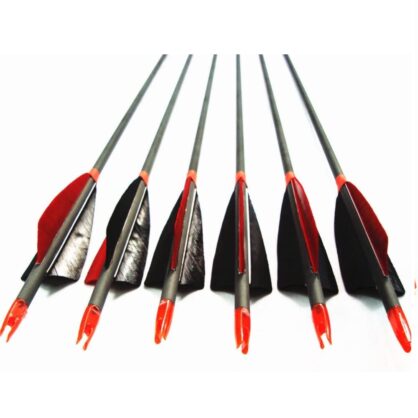 If you’re serious about your archery, you need an arrow that can keep up with your intensity and precision. MS Jumpper Archery Carbon Arrows are designed for hunting and competition, with a replaceable screw-in stainless steel field point and 4-inch real feather + carbon fiber shaft.
If you’re serious about your archery, you need an arrow that can keep up with your intensity and precision. MS Jumpper Archery Carbon Arrows are designed for hunting and competition, with a replaceable screw-in stainless steel field point and 4-inch real feather + carbon fiber shaft.
These arrows are 28-30 inches long and made of top quality materials, ensuring good performance and low hand shock. [1] With their good speed and impressive accuracy, MS Jumpper Archery Carbon Arrows will help you take your game to the next level.
When it comes to carbon hunting arrows, you can’t go wrong with MS Jumpper Archery Carbon Arrows. With their top quality materials, good speed and accuracy, and low hand shock, these arrows will help you take your game to the next level. And at just $32.39 for a 6-pack, they’re a great value for the money. So if you’re looking for the best carbon hunting arrows around, be sure to check out MS Jumpper Archery Carbon Arrows. You won’t be disappointed.Letszhu Hunting Archery Carbon Arrow – Perfect choice for amateurs or archers shooting!
 Letszhu Hunting Archery Carbon Arrow is made of high quality carbon with great strength and durability. It has excellent straightness and great speed. The arrow is 28 inch long and can be used with different types of bows like compound recurve and longbows. The feathers are real turkey feathers which give it good stability in flight.
Letszhu Hunting Archery Carbon Arrow is made of high quality carbon with great strength and durability. It has excellent straightness and great speed. The arrow is 28 inch long and can be used with different types of bows like compound recurve and longbows. The feathers are real turkey feathers which give it good stability in flight.
The nock is adjustable so that you can get the perfect fit for your bow. The arrowheads are 100 grain and are removable for easy replacement. This product is perfect for archery target shooting and outdoor hunting. It comes in a pack of 6 arrows. [2]
Overall, the Letszhu Hunting Archery Carbon Arrow is a great product for those looking for quality arrows. The main downside is the price, but if you are willing to spend the extra money, this arrow is definitely worth it.Pinals Archery Carbon Arrows – Top quality!
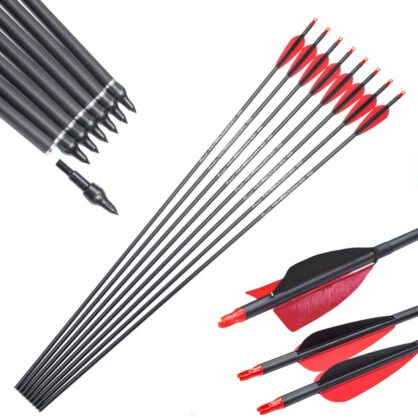 Looking for the perfect arrows for your recurve or compound bow? Look no further than the Pinals Archery Carbon Arrows! These arrows are made of pure carbon for ultimate strength and straightness, and are available in a variety of spine sizes to suit your needs. They come with 3 inch plastic or 4 inch right wing turkey feather fletches, and 100 grain points.
Looking for the perfect arrows for your recurve or compound bow? Look no further than the Pinals Archery Carbon Arrows! These arrows are made of pure carbon for ultimate strength and straightness, and are available in a variety of spine sizes to suit your needs. They come with 3 inch plastic or 4 inch right wing turkey feather fletches, and 100 grain points.
The adjustable nocks make them easy to use with any bow, and they’re perfect for practice, competition, or hunting. [3]
Overall, the Pinals Archery Carbon Arrows are a great choice for anyone looking for high-quality, durable arrows. They’re perfect for both practice and competition, and come in a variety of spine sizes to suit your needs. The only downside is that they don’t last as long as some other types of arrows, but they’re still a great choice for anyone looking for a high-quality arrow.MS Jumpper Hunting Carbon Arrows – Good choice too!
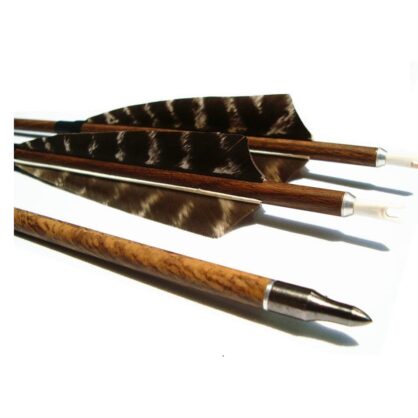 The MS Jumpper Hunting Carbon Arrows are perfect for those who are looking to get the most out of their hunting experience. Made with high quality materials, these arrows are designed for precision and accuracy, so you can take down your target with ease.
The MS Jumpper Hunting Carbon Arrows are perfect for those who are looking to get the most out of their hunting experience. Made with high quality materials, these arrows are designed for precision and accuracy, so you can take down your target with ease.
The replaceable screw-in stainless steel field point and real feather shafts give you the stability and power you need to make the perfect shot, while the 4-inch carbon fiber nocks provide superior strength and durability. With a 28-30 inch arrow length, these arrows are sure to provide you with the performance you need to make your next hunting trip a success. [4]
The MS Jumpper Hunting Carbon Arrows are an excellent choice for those looking to get the most out of their hunting experience. If you’re in need of a new set, these should be at top!Guide Gear Trophy Archery Hunting Arrows – Editors choice!
 Whether you’re practicing your shot or aiming for the trophy, you’ll appreciate the quality and performance of the Guide Gear Trophy Archery Hunting Arrows. Made to our exacting standards by Victory Archery, these arrows are constructed of 100% standard modulus carbon for durability and consistent flight.
Whether you’re practicing your shot or aiming for the trophy, you’ll appreciate the quality and performance of the Guide Gear Trophy Archery Hunting Arrows. Made to our exacting standards by Victory Archery, these arrows are constructed of 100% standard modulus carbon for durability and consistent flight.
The 31-inch arrows are equipped with 2″ Bohning Blazer vanes in a right helical configuration for improved accuracy, and come in a pack of six. Choose between .350″ and .500″ spine options to perfectly match your bow, and enjoy the satisfaction of hitting your target time after time. [5]
Overall, these are great arrows for the price. If you are looking for a good quality carbon hunting arrow, we would recommend giving the Guide Gear Trophy Archery Hunting Arrows a try.The Buyer’s Guide
Hunting Arrow Basics
Carbon hunting arrows are shafts that are made from carbon fiber. They’re designed for use with bows and crossbows, and they offer a number of advantages over traditional arrows.
One of the biggest benefits of using a carbon hunting arrow is that they’re much lighter than traditional arrows. This makes them easier to shoot, and it also means that they’re less likely to cause fatigue over the course of a long day of hunting.

Another advantage of carbon hunting arrows is that they’re very strong and durable. They can withstand a lot of abuse, which is ideal for hunters who often find themselves in rough terrain.
Finally, carbon hunting arrows are also very accurate. Because they’re so light, they tend to fly straight and hit their target more consistently than heavier arrows.
So, if you’re in the market for a new hunting arrow, carbon is definitely the way to go.
Anatomy Of An Arrow
The 5 main parts of an arrow are the tip, the insert, the shaft, the fletching, and the nock.
The Tip
The tip is the part of the arrow that actually pierces the animal, so it’s important to choose one that will be effective.
Fixed tips are exactly what they sound like- they’re permanently attached to the shaft of the arrow. Mechanical tips, on the other hand, are designed to detach from the shaft on impact.
This can be useful for hunters who want to reuse their arrows, as it minimizes damage to the shaft.
The Insert
The insert is the part of the arrow that connects to the string. It also provides weight at the front end of the arrow to help with stability in flight. Inserts can be made from different materials, but most commonly they are made from brass or aluminum. Some inserts are even made from carbon fiber.
There are two main types of inserts: screw-in and glue-in.
Screw-in inserts are just what they sound like – they screw into the shaft of the arrow.
Glue-in inserts are glued into place using epoxy or another type of adhesive. Either type of insert can be removed and replaced if necessary.
Most hunting arrows will have weight added to them in the form of an insert. This helps to make the arrow more stable in flight and also allows for the use of heavier broadheads. Heavier broadheads can penetrate deeper, making them ideal for hunting big game animals.
If you are using an insert that is not properly glued or screwed in, it can come loose during flight and cause your arrow to veer off course. This is why it is important to make sure that your inserts are installed correctly before shooting.
The Shaft
The shaft is the main body of the arrow. It is usually made of carbon or aluminum and is what determines the overall strength and stiffness of the arrow. The length of the shaft will also affect the accuracy of your shots. A longer shaft will be more stable in flight but may be more difficult to control. A shorter shaft will be easier to control but may not be as accurate. You will need to experiment with different lengths to find what works best for you.
The Fletching
The fletching is the plastic or feathers that are glued to the back end of the arrow and stabilize it in flight. Most arrows come with three fletchings, but some have four or even five. The most common fletching colors are white, red, and yellow, but you can find them in just about any color these days.
There are two main types of fletching: vanes and feathers.
Vanes are made of plastic and feathers are, well, feathers. Each has its own advantages and disadvantages.
Vanes fletching faster and easier to replace if they get damaged. They’re also less likely to be affected by moisture than feathers. On the downside, they’re not quite as stable in flight as feathers and can be more difficult to tune.
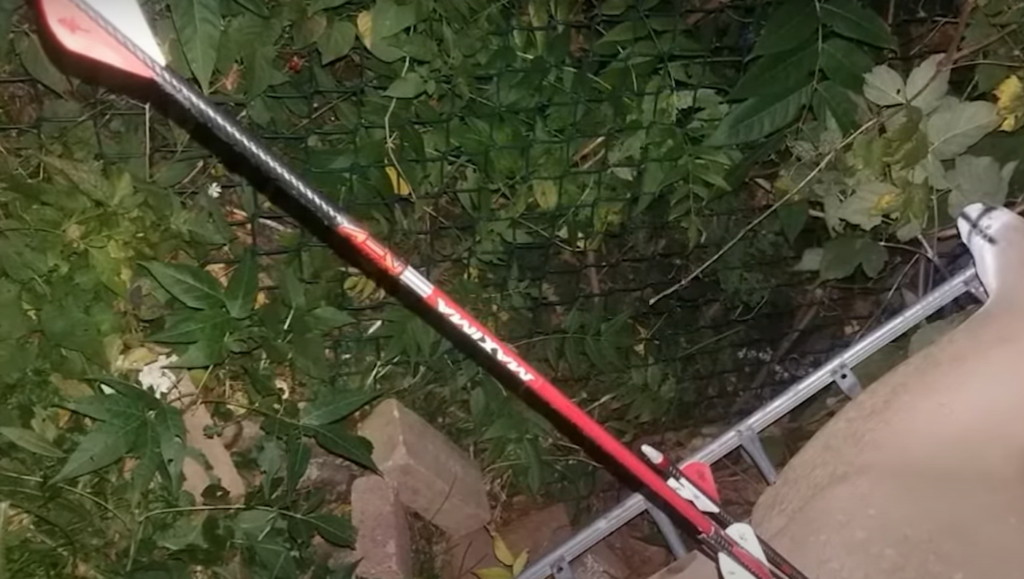
Feathers are more stable in flight than vanes and easier to tune, but they’re also more delicate and can be damaged more easily. They also tend to hold moisture longer than vanes, which can affect their performance.
So, which is better? It really depends on your personal preferences. If you’re just starting out, vanes might be the way to go because they’re cheaper and easier to replace. But if you’re looking for the best possible performance, feathers are the way to go.
One final thing to keep in mind is that you can get fletchings in different shapes. The most common shape is called helical, which is where the vanes or feathers are spiraled around the shaft. This is the most aerodynamic shape and will give you the best arrow flight.
You can also get straight fletchings, which are just vanes or feathers that are glued on straight. These are less aerodynamic than helical fletchings but some people prefer them because they’re easier to tune.
The Nock
The nock is the plastic piece at the back of the arrow that you snap your bowstring into. [7]
There are two main types of nocks: flatback and half moon. Flatback nocks are the most common type and they work with most bows. Half moon nocks are designed for use with specific bows, such as recurve bows, and they offer a more secure connection between the string and arrow.
Arrow Wraps
If you are shooting a bare shaft or just want to get creative, there are many different ways that you can dress up your arrows with wraps and shrink tubes. This is purely for aesthetics and has no effect on the performance of the arrow. There are many different companies that make these products and they come in a wide variety of colors and patterns. You can even get custom made ones with your initials or favorite sports team logo. If you want to go all out, you can even have them glow in the dark!
Arrow wraps are simply strips of vinyl that you wrap around the shaft of the arrow. They are easy to apply and remove, so you can change them as often as you like. Shrink tubes are made of heat shrinkable plastic that you slip over the shaft of the arrow and then heat with a heat gun or hair dryer. This shrinks the tube down so that it is snug against the arrow. They are more permanent than wraps, but can also be removed if you need to.
When applying wraps or shrink tubes, it is important to make sure that they are applied straight and evenly. If they are not, it will cause the arrow to fly erratically. Also, make sure that there are no gaps or bubbles. If there are, the arrow will not spin properly and will again affect its flight.
That way, if you make a mistake, it won’t cost you a new arrow!Choosing The Correct Arrow
Spine
The spine of an arrow is the thickness of the shaft and is measured in thousandths of an inch. The heavier the draw weight of your bow, the stiffer spine you will need to prevent your arrows from flexing (bending) too much when shot. Too much flex will result in a loss of accuracy.

There are a few ways to determine what size spine you need. One way is to consult with an archery shop or manufacturer. Another way is to use a spine chart which takes into account two variables: arrow length and draw weight. You can find many good charts online by doing a simple search.
Length
Carbon hunting arrows come in a variety of lengths. Longer arrows are safer to shoot because they are less likely to snap upon release. Shorter arrows are more maneuverable in the air, making them better for hunting purposes. [8]The most common length is 30 inches, but some people prefer shorter or longer arrows. The length of the arrow you need depends on the draw length of your bow. To find out your draw length, consult a professional or use an online calculator.
Diameter Straightness
Diameter is important because it affects both the aerodynamics and penetration of the arrow. A smaller diameter means less wind resistance and more penetration. However, a smaller diameter also means less stability, which can affect accuracy.
The straightness of an arrow is measured by the amount of deviation from a perfectly straight line. The industry standard for acceptable straightness is +/- .006 inches. Most arrows are within this range, but there are some that claim to be even straighter. A straighter arrow will be more accurate than one that is not as straight.
Weight
Carbon hunting arrows are generally lighter than aluminum arrows, which makes them easier to shoot for extended periods of time. This can be a big advantage when you’re out in the field all day and need to stay focused.
Tip Weight
The weight of the tip is one of the main things to look for when choosing arrows. A heavier tip will result in more penetration, while a lighter tip will be easier to shoot but won’t penetrate as well.
For hunting, you’ll want an arrow with a heavier tip so that it can penetrate thick hide and bone.
Arrow Types
Fiberglass
Fiberglass arrows are the most popular type of arrows on the market. They’re durable, reliable and relatively inexpensive. But when it comes to hunting, you need something that’s going to give you the best possible chance of bringing down your prey.
Carbon Fiber
Carbon arrows are lighter and faster than traditional metal arrows, making them ideal for hunters who want to increase their accuracy and success rate.
Wood
Wooden arrows are beautiful. They have a classic look that is hard to beat. But they are not the best choice for hunting.
Aluminum
Aluminum arrows are the most popular type of arrows on the market. They are made of a strong and lightweight metal that is perfect for hunting.
Carbon Aluminum/Carbon Composite
These are the most popular type of arrows on the market, and for good reason. They offer a great combination of durability and speed, making them ideal for hunting purposes. Carbon aluminum or carbon composite arrows also tend to be very accurate, which is another plus in their favor.
A Note About These Materials
There are a few different materials that arrows can be made out of, but for hunting, you really only have two options: aluminum or carbon.
Wooden, fiberglass, and other materials just can’t give you the same strength or durability that you need for hunting. They also tend to be too heavy, which will affect your accuracy.
Measurements For Different Arrow Materials
The most important thing when it comes to picking the right arrows is getting the measurements correct. This is because different arrow materials have different weights and dimensions. So, before you purchase anything, make sure to consult a professional or do your research so that you know exactly what you need. Here are some general guidelines for different arrow materials:
- Carbon Arrows: These are the most popular choice for hunters. They are lightweight and offer good accuracy. The downside is that they can be brittle and may break if you hit something hard. The length of a carbon arrow should be around 30 inches.
- Aluminum Arrows: These are a bit heavier than carbon arrows but are also more durable. They are a good choice for beginners or those who are looking for a more affordable option. The length of an aluminum arrow should be around 32 inches.
- Wooden Arrows: These are the heaviest and most traditional types of arrow. They are very durable but can be difficult to control. The length of a wooden arrow should be around 34 inches.
Tips And Considerations
- When choosing a tip for your carbon hunting arrow, there are a few things you’ll need to keep in mind.
- First, consider what type of game you’ll be hunting.
- If you’re going after larger animals, you’ll need a tip that can penetrate deep into the flesh. For smaller games, a lighter tip will do the job just fine.
- You’ll also want to consider the type of bow you’re using. If you’re using a compound bow, for example, you’ll need a heavier tip than if you were using a recurve bow.
- If you’re not sure what weight of tip to choose, it’s always better to err on the side of a heavier tip. You can always remove weight from the arrow if you find it’s too heavy, but you can’t add weight if the arrow is too light.
Some Arrow-Selecting Tips For Hunters
When it comes to choosing arrows, hunters can be pretty particular. And for good reason: the right arrow is essential for a successful hunt.

Here are a few factors to consider when making your selection:
- Draw Weight: The amount of force needed to draw the bow and fire an arrow. Draw weight is measured in pounds; most bows have a draw weight between 20 and 70 pounds.
- Spine: This is the stiffness of the arrow shaft and is measured in thousandths of an inch. A higher number means a stiffer arrow.
- Length: The length of the arrow should be based on the hunter’s draw length (the distance from the bowstring to the back of the hand when the bow is drawn).
- Fletching: The feathers or vanes on the end of the arrow that stabilize flight.
- Tip Weight: The weight of the point on the front of the arrow, which is measured in grains. Heavier tip weights are better for penetration, while lighter tip weights are better for accuracy.
Safety
Archery Safety
When practicing or competing in archery, always follow the safety rules set by your local Archery Club or organization. In general, these rules require that participants:
- Wear appropriate eye and ear protection
- Be aware of their surroundings and who/what is behind their target [6]
- Use arrows that are properly sized for their bow
- Inspect their equipment before each use
- Never shoot at hard surfaces or water
Bowhunting Precautions
The best carbon hunting arrows are those that are able to withstand the challenges of bowhunting. However, before using carbon hunting arrows, it is important to take some precautions. First and foremost, always use a release aid when shooting. This will help to prevent the string from slipping and causing the arrow to fly off course. Secondly, make sure that the arrows are properly fletched. This will ensure that they fly straight and true. Finally, always practice shooting before going out on a hunt. This will help to ensure accuracy and prevent injury.
Follow these simple tips and you will be sure to have a successful and safe bowhunting experience.
FAQ
How do I know what arrows to use?
For that you need to check the number on the spine of your arrows. This will tell you how stiff the arrow is. If it’s too soft, it will bend on impact and make for poor accuracy. If it’s too stiff, the arrow will fly erratically.
What do the numbers mean on arrows?
The numbers on arrows generally refer to the spine of the arrow. The spine is the measurement of how much an arrow bends, and is measured in thousandths of an inch. A higher number means a stiffer arrow, while a lower number indicates a more flexible arrow.
Why is the spine of an arrow important?
The spine of an arrow is important because it determines the amount of flex in the arrow. A higher spine number means less flex, and a lower spine number means more flex.
How do I remove my old fletching?
To remove the old fletching, start by removing the nock from the arrow. Then, use the arrow puller to remove the old fletching. If the fletching is glued on, you may need to use a razor blade or knife to cut it off. Once the old fletching is removed, you can start adding the new fletching.
How do I measure the correct arrow length?
The first step is to measure your draw length. This is the distance from the nock of the arrow to the deepest part of the bow grip, with the bowstring fully drawn. Once you have this measurement, you can use a chart to find the corresponding arrow length.
Are shorter arrows more accurate?
The answer to this question is a resounding yes! Shorter arrows are more accurate for two primary reasons: they’re less affected by wind and they have a higher kinetic energy.
When it comes to wind, the shorter the arrow, the less surface area there is for the wind to catch. This makes a big difference when you’re shooting at long range, as even a slight breeze can push a longer arrow off course.
As for kinetic energy, the shorter the arrow, the more compact the energy is. This results in less energy being lost to friction and also makes the arrow more stable in flight. In other words, it’s less likely to wobble and will fly straighter.
So if you’re looking for improved accuracy, go with a shorter arrow!
How many arrows should I take hunting?
The answer to this question largely depends on the game you’re hunting. Small games require fewer arrows, while large games might need more. You should also take into account how difficult the terrain is and how likely you are to lose arrows. In general, it’s always better to err on the side of taking too many arrows rather than not enough.
Should arrows go through deer?
This is a common question with a lot of hunters, and the answer is no; your arrows should not go all the way through the deer. Not only is it wasteful, but it can also cause you to lose your arrow if it gets lodged in the ground. A good rule of thumb is to have your arrows penetrate the deer by at least six inches; this will ensure that you get a clean kill and won’t lose your arrow.
Should your arm be straight when shooting a bow?
The answer is no, you should not shoot with a completely straight arm. When you extend your arms out to shoot, there should be a slight bend in your elbow. This will help you to have more control over the bow and arrow.
If you shoot with a completely straight arm, the bowstring will hit your arm when you release the arrow. This can cause the arrow to go off course, and it can also be painful. So, make sure to keep a slight bend in your elbow when you shoot.
Why are my arrows curving?
One of the most common questions we get asked is: why are my arrows curving? The answer, unfortunately, is not always a simple one. It could be a number of things, but the most common is that your arrows are not properly spined for your bow. This means that the weight and stiffness of the shaft is not matched to the draw weight and let-off of your bow.
How do I make my arrow act stiffer in the spine?
There are a few ways to make an arrow stiffer in the spine. One way is to use a smaller diameter shaft. Another way is to use a material that is more stiff in nature such as carbon fiber.
How do I make my arrow act weaker in the spine?
If you have a heavier draw weight, you can make your arrow act weaker in the spine by adding more weight to the front of the arrow. This will make the arrow bend more when it hits the target, which will absorb some of the kinetic energy and reduce penetration.
Useful Video: Best Arrows 2021 | Top 5 Arrows for Hunting
Conclusions
There’s a lot to consider when choosing the best carbon hunting arrows for your needs. We hope this guide has been helpful in narrowing down your options and giving you some things to think about. As always, be sure to do your own research before making any final decisions.
Thank you for reading!
References:
- https://www.amazon.com/MS-Jumpper-Percentage-Carbon-Fiber-Targeting/dp/B06XF5H7JM
- https://www.amazon.com/Letszhu-Practice-Fletched-Feathers-Compound/dp/B076LF9Q9C
- https://www.amazon.com/Pinals-Archery-Compound-Recurve-Longbow/dp/B08HKGMSDQ
- https://www.amazon.com/Archery-Hunting-MS-Replacement-Compound/dp/B01MECQEJI
- https://www.amazon.com/Guide-Gear-Trophy-Victory-Archery/dp/B07J1RLTKN
- https://www.victoryarchery.com/safety/
- https://www.completeguidetoarchery.com/how-to-choose-arrows-a-guide/
- https://www.nockout.com/arrow-buying-guide-need-know/

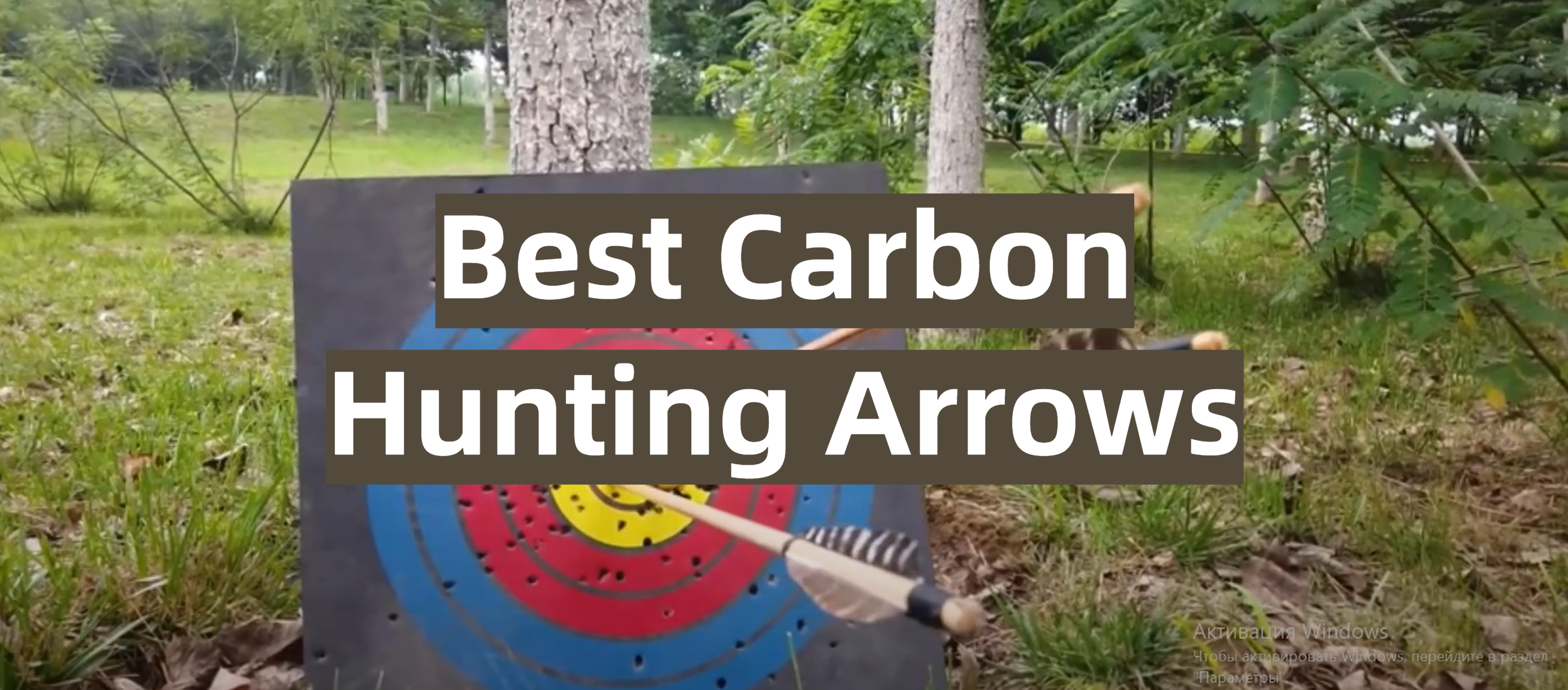




Leave a Reply